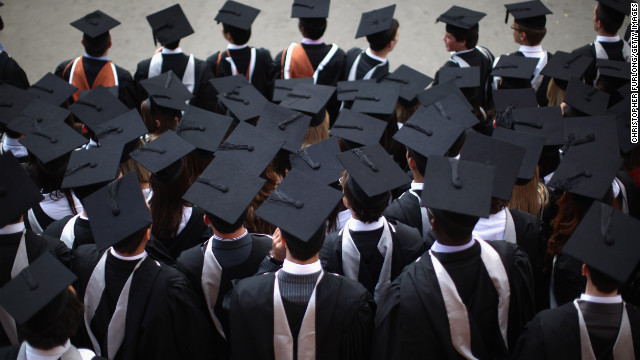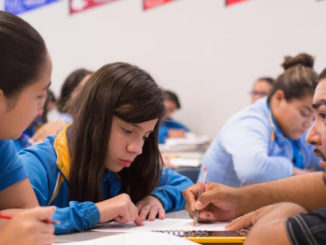
Last week, an NPR affiliate threw super-cooled water on D.C.’s Ballou High School’s so-called success in graduating 64 percent of its seniors and earning every senior, regardless of whether they graduated, college acceptance. Turns out that, although 164 students were granted diplomas, more than half of those who walked across the graduation stage tallied at least sixty days of unexcused school absences, and one cap-and-gown wearer recorded more than 150.
As shocking as these seat-time revelations are, they merely add to other signs of academic struggle at Ballou. Last year, for example, only 9 percent of the school’s pupils passed the English language arts portion of D.C.’s annual standardized test. None passed the math portion.
Perhaps even worse, considering that all of these young people may now be college-bound, are the school’s woeful SAT scores. Last year, the average total score was 782 out of 1600, which falls into the 11th percentile nationwide, and 8th percentile among SAT users. That score represents the sum of the exam’s two “objective” parts—essentially reading and math—and Ballou’s scores were equally low in both, earning a 382 and 381, respectively. Neither is remotely close to the exam’s college-readiness benchmark. The College Board, which administers the test, communicates a score’s distance from that benchmark with a series of colors: green, yellow, and red. “Red” means that an SAT score is “below the benchmark by more than one year’s academic growth.” The color’s cutoff in reading and writing is 450; in math it’s 500.
Ballou is far from a unique case. Rather, it’s a recent and extreme example of a nationwide issue. “This is sad and infuriating and, as local education reporters across the country know, not at all uncommon,” tweeted Erica L. Green, an education reporter at the New York Times. Indeed, just weeks before the Ballou story broke, a report from D.C.’s neighboring Prince George’s County, Maryland, found that 25 percent of that district’s high school graduates may not have met requirements.
So what in the world does a diploma now indicate? Not that students are ready for college. Not that they’ve learned as much as twelfth graders should learn. Not even, apparently, that they’ve shown up for school. Is it nothing more than a redundant certification that these graduates are old enough to finish twelfth grade and enter some version of adulthood? Has the high school diploma therefore lost all academic meaning? There’s a good chance that it has. And in losing all meaning, the farcical meaning that schools purport to assign to it harms our most vulnerable, disadvantaged students, especially now that America’s high school graduation rate is at an all-time high.
When a young man or woman who is sorely unprepared for college enters college, that person has but a faint hope of succeeding. And when they fail, they’re worse off than had they never gone at all. At the very least, time that could’ve been spent building a career is wasted. And that cost is often compounded by serious financial debt in the form of loans for tuition, room, and board. When the person then leaves college without skills, a degree, or other credentials and struggles to find a job, interest on those loans accrues, and soon the young person is drowning in oppressive debt.
This, of course, disproportionately affects disadvantaged and low-performing students. Just 40 percent of black enrollees at four-year public universities graduate within six years, for example, 21 percentage points below their white peers, and 18 percentage points below the nationwide average. And it’s far worse for students who must take remedial courses because they aren’t prepared for college classes when they arrive on campus. Fifty percent never complete their remedial education, and less than 25 percent who attend community college earn a degree within eight years.
In short, the situation has grown absurd and untenable. We’ve simultaneously lowered the bar for high school graduation while pushing for more high school graduates to attend college. Things, therefore, must change.
First, let’s once and for all eradicate the soft bigotry of low expectations. Understandable is the urge to make exceptions for struggling students while they’re in school. But sooner or later they must enter the real, unforgiving adult world. And when we tell these young men and women that they’ve developed the skills to succeed when they, in fact, have not, we’re causing serious long-term harm for the very people we’re trying to protect in the short-term.
Second, stop pretending that college should be for everyone. Career and technical education is a promising, underrated, and underutilized avenue in our schools. Make more of those options available to students, and show our young people that there’s nothing wrong—and a lot right—with pursuing a vocation. Being a lawyer, for example, isn’t an inherently better profession than being an electrician or a carpenter. And, despite at least seven years of higher education, lawyers often make less money.
Third, rethink the high school diploma. Base it on demonstrated competency rather than time in school or Carnegie units compiled. Or consider, as my colleague Checker Finn has suggested, instituting a multiple-tier system in which college-bound students receive, say, “academic” diplomas, and those who are career-bound get “applied” diplomas that signal more practical things, like responsibility, reliability, or on-the-job skills. This would not be tracking by a different name; both options would have a whole lot in common, and every student would have the option to choose either at any time.
Fourth, stop holding schools accountable for easily gameable and therefore mostly meaningless metrics like graduation rates. When you condition adults’ livelihoods on whether students walk across a stage wearing a cap and gown, more and more students will do so, regardless of academic accomplishment. Focus instead on measures that are more representative of knowledge and success, like academic growth measured by high quality assessments.
Steps like these will help eliminate the perverse incentives that culminate in outcomes like Ballou’s. American education should prepare our kids to be well-adjusted, successful adults. That goal should inform every decision and should always be considered when we examine the direct and indirect consequences of our policies. In failing at this we’ve failed our students and ultimately failed the country they will inhabit, too.



